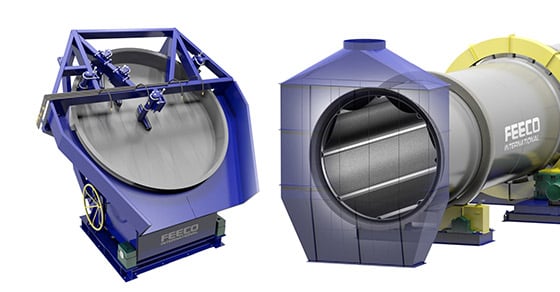When it comes to building a pelletizer plant, producers are often faced with the decision of choosing between a rotary drum agglomerator and a disc pelletizer (pan granulator). Though the choice may seem overwhelming at first, there are many things to take into account that will help to make the right decision for the material and process goals at hand.
Material Specific Considerations
Many times the choice between a rotary drum and a pan pelletizer is dependent upon historical preference. Throughout various industries, one or the other has been used for generations, and there is no need for change. Taking a look at the pros and cons of each can help to make an informed decision.
Process Recycle
There are many differences between a drum and a disc, but whether they are an advantage or a disadvantage is often dependent upon the material. This is clear when looking at the amount of recycle in a process.
Overall, a pelletizer results in far lower recycle than a rotary drum does. This is ideal in situations where the material goes from a pelletizer to a dryer, because the less recycle that has to be dried, the more efficient the process will be (i.e., the more recycle that needs to be dried, the more energy spent on drying there will be).
While rotary drums may result in a higher amount of recycle, this recycle can also be beneficial to a process. For example, when utilizing a rotary drum agglomerator, the higher amount of recycle acts as a buffer in the process. If there is any upset in conditions, there is enough recycle in the process to help even things out. However, with a pelletizer, there is such little recycle, that when there is an upset in conditions, the output is almost immediately affected.
Additionally, some material processes require a certain amount of recycle to function efficiently, and whether using a drum or pan, extra recycle is advantageous. Such is often the case when a pin mixer is introduced into the process. Some materials require a certain amount of recycle to be mixed in with the dry feedstock going into the pin mixer, in order for the feedstock to mix efficiently before going into the pelletizer. For this reason, it is often a requirement to have a little more recycle on hand.
Customization and System Considerations
Desired Throughput of the Pelletizer Plant
Another aspect to consider when choosing between a rotary drum agglomerator and a disc pelletizer, is the throughput. When it comes to running a very high capacity, rotary drums are often the equipment of choice. Typically, rotary drums can handle a much higher throughput than a pan pelletizer can. Where it might take a few pelletizers to get to the desired capacity, it may only take a single drum to reach the same capacity.
While rotary drums allow for a higher throughput, disc pelletizers are the equipment of choice when a tight window of size range is desired for the output product.
Product Refinement
Creating pellets on a pelletizer has been likened to a form of art, allowing for extreme customization and fine-tuning of product. Pan speed, pan angle, pan depth, feed location, and binder location are all things that can be adjusted to zero-in on the size range (among other qualities) of the pellets. However, this also means a pelletizer requires a much more watchful eye than a rotary drum agglomerator. Where one operator would be capable of watching several drums, one operator should only watch a few pan pelletizers.
Rotary drums are far more “limited” in terms of customization, offering fewer variables for adjusting end product, but subsequently, requiring less monitoring.
Open or Closed System
Another side to consider in the choice between a rotary drum and disc pelletizer, is whether or not a closed system is desired. Rotary drums are considered a “closed system,” because the agglomerating happens within the drum, meaning the vessel can be sealed to help control dust and odor. The disc pelletizer is considered an open system, because the operation happens in a less sealed atmosphere than a drum, though hoods are available for containing material on the disc.
Maintenance
Disc pelletizers require somewhat less maintenance than a rotary drum. Though pelletizers do need to be maintained properly in order to function efficiently, there are fewer parts to be replaced, typically only scrapers and spray nozzles. With rotary drums, there are many parts that not only require regular maintenance, also need replacing now and then. It’s important to note that the performance of either piece of equipment is severely hindered if not properly maintained.
Conclusion
While material characteristics (such as how quickly a material pelletizes, particle size distribution, binder reaction time, etc.) can play a role in the choice between a pelletizer or a rotary drum agglomerator, ultimately, the choice comes down to what works best for the process and material to be pelletized.
FEECO has been a leader in the agglomeration industry for over 70 years, manufacturing rotary drum agglomerators, and disc pelletizers to suit the needs of specific process and material goals. We can run agglomeration feasibility tests in our state-of-the-art testing facility to aid in the decision of what is right for your process and material. For more information, contact us today!

